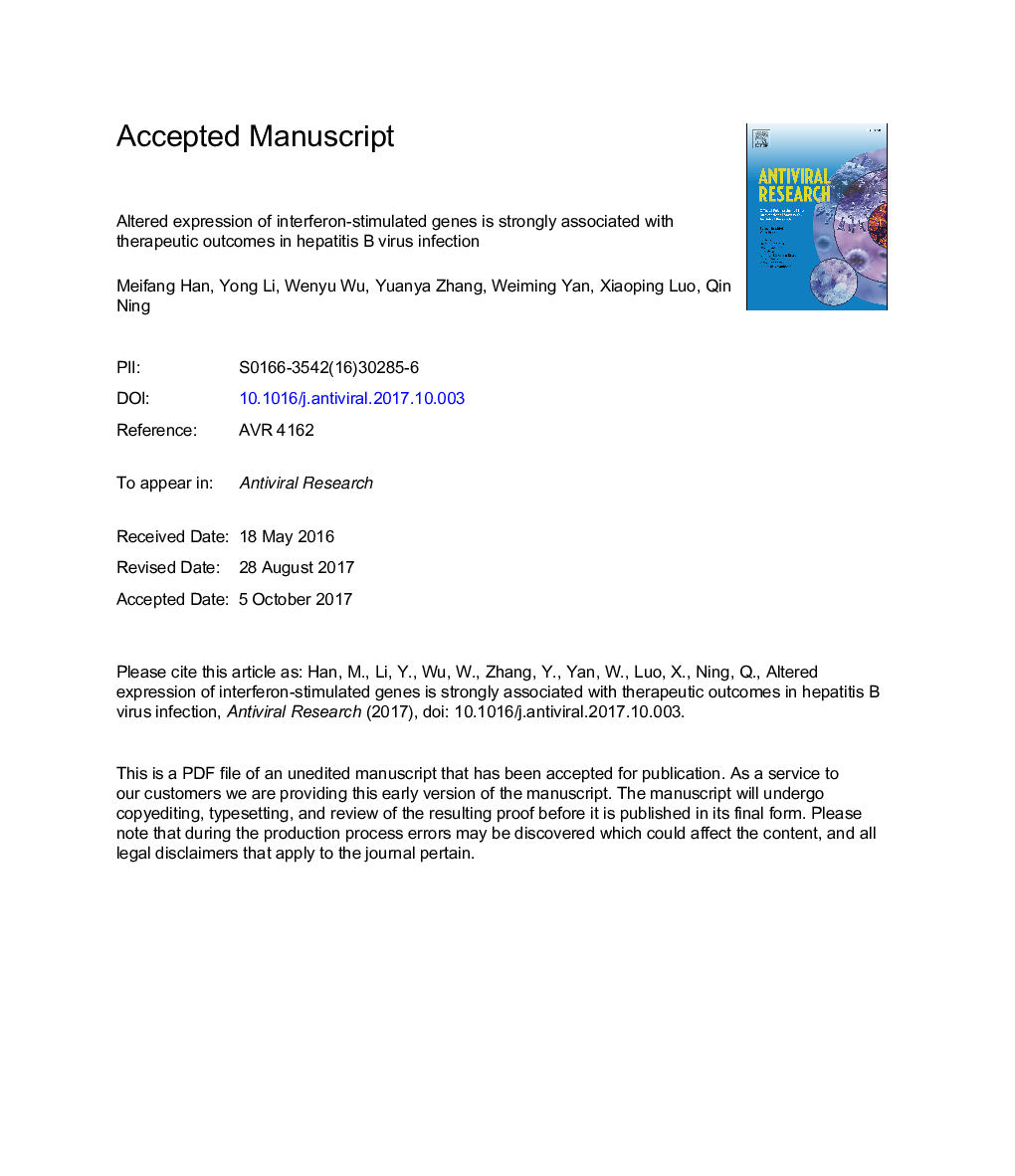| کد مقاله | کد نشریه | سال انتشار | مقاله انگلیسی | نسخه تمام متن |
|---|---|---|---|---|
| 8523482 | 1557796 | 2017 | 39 صفحه PDF | دانلود رایگان |
عنوان انگلیسی مقاله ISI
Altered expression of interferon-stimulated genes is strongly associated with therapeutic outcomes in hepatitis B virus infection
دانلود مقاله + سفارش ترجمه
دانلود مقاله ISI انگلیسی
رایگان برای ایرانیان
کلمات کلیدی
HBsAbCHBcccDNAmyxovirus resistance protein ASOCS3PKRPEG-IFNhepatitis B e antibodyHBsAgRNA-activated protein kinaseHBeAgPBMCsISGF3ETVHBeAbNASIRF9GAPDHInterferon regulatory factor 9Janus kinase - کیناز جانوس 2′,5′-oligoadenylate synthetase - 2 '، 5'-oligoadenylate synthetasecovalently closed circular DNA - DNA متصل به جنس مخالف بسته شده استHCC - HCCISGs - ISG هاStat1 - sTAT1STAT - آمارHepatitis B surface antigen - آنتی ژن سطحی هپاتیت BEntecavir - انکاویرPegylated interferon - اینترفرون تقویت شدهAntiviral therapy - درمان ضد ویروسیsuppressor of cytokine signaling 3 - سرکوب سیگنالینگ سیتوکین 3hepatitis B surface antibody - سطح آنتی بادی هپاتیت Bperipheral blood mononuclear cells - سلول های تک هسته ای خون محیطیinterferon-stimulated gene factor 3 - عامل ژن تحریک کننده اینترفرون 3signal transducers and activators of transcription - مبدل سیگنال و فعال کننده رونویسیHepatitis B e antigen - هپاتیت B آنتی ژنchronic hepatitis B - هپاتیت B مزمن، هپاتیت ب مزمنHBV - هپاتیت بhepatitis B virus - ویروس هپاتیت بیJAK - چگونهInterferon-stimulated genes - ژن های تحریک کننده اینترفرونHepatocellular carcinoma - کارسینوم هپاتوسلولار(کارسینوم سلولهای استخوانی)
موضوعات مرتبط
علوم زیستی و بیوفناوری
ایمنی شناسی و میکروب شناسی
ویروس شناسی
پیش نمایش صفحه اول مقاله

چکیده انگلیسی
Our previous OSST study shows that switching to pegylated interferon (Peg-IFN)-α2a results in higher rates of response hepatitis B e antigen (HBeAg) seroconversion and hepatitis B surface antigen (HBsAg) loss at the end of treatment, compared with nucleot(s)ide analogues (NAs) monotherapy in long term NA-treated chronic hepatitis B (CHB) patients. In order to characterize the correlation between Peg-IFN-α antiviral effect and IFN-inducing signaling in CHB patients who switched to Peg-IFN from long time entecavir (ETV) treatment, we investigated the dynamic expression of interferon-stimulated genes (ISGs), including STAT1, MX, and a negative regulatory factor, suppressor of cytokine signaling 3(SOCS3), which negatively regulate IFN JAK-STAT signaling pathway by interacting with STAT1 and STAT2, in peripheral blood and paired liver samples, obtained from 54 CHB patients enrolled in a clinical trial, OSST study. In Peg-IFN group, responders showed a more significant decline in HBsAg, compared with non-responders. Following the treatment, peripheral blood and hepatic STAT1 and MX expression levels were higher in Peg-IFN responders, while SOCS3 expression was higher in non-responders. Fold induction of STAT1 at week 4 and MX at week 12 in PBMCs directly correlated with HBsAg decline at week 48 relative to the baseline. Responders showed a significantly increased activation and nuclear localization of phospho-STAT1 following Peg-IFN treatment, compared with non-responders in liver. Whereas, non-responders exhibited significantly higher hepatic expression of SOCS3 before the treatment compared with the responders and even higher expression levels after the treatment compared with the baseline, which may be involved in the mechanism of IFN resistance.
ناشر
Database: Elsevier - ScienceDirect (ساینس دایرکت)
Journal: Antiviral Research - Volume 147, November 2017, Pages 75-85
Journal: Antiviral Research - Volume 147, November 2017, Pages 75-85
نویسندگان
Meifang Han, Yong Li, Wenyu Wu, Yuanya Zhang, Weiming Yan, Xiaoping Luo, Qin Ning,